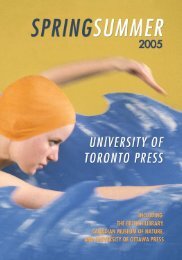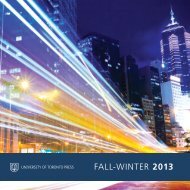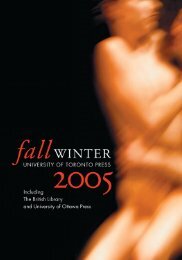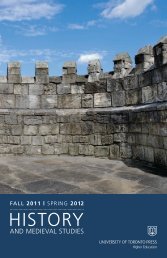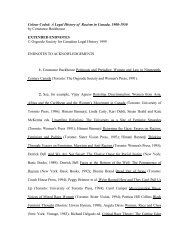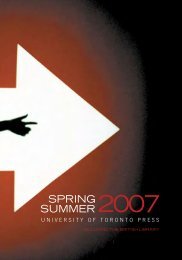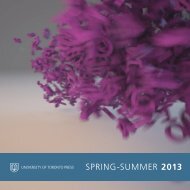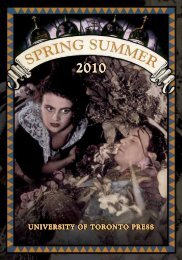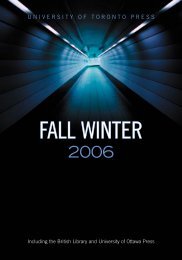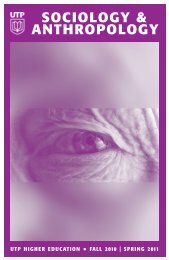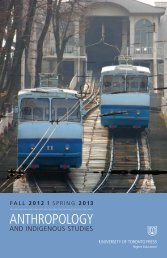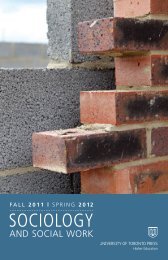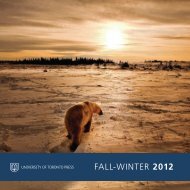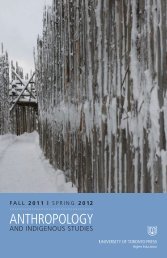Classics, Medieval & Renaissance 2012 - University of Toronto ...
Classics, Medieval & Renaissance 2012 - University of Toronto ...
Classics, Medieval & Renaissance 2012 - University of Toronto ...
You also want an ePaper? Increase the reach of your titles
YUMPU automatically turns print PDFs into web optimized ePapers that Google loves.
FEATURED TITLES<br />
NEW<br />
The Taymouth Hours<br />
Stories and the Construction <strong>of</strong> the Self in Late <strong>Medieval</strong> England<br />
Kathryn A. Smith<br />
The Taymouth Hours is one <strong>of</strong> the most fascinating<br />
illuminated manuscripts <strong>of</strong> late medieval England,<br />
but the circumstances <strong>of</strong> its commission have<br />
remained elusive for more than a century. In this<br />
first comprehensive study <strong>of</strong> the Taymouth Hours,<br />
Kathryn A. Smith traces the manuscript’s origin to<br />
Philippa <strong>of</strong> Hainault, queen <strong>of</strong> Edward III, and Edward’s<br />
sister, the thirteen-year-old Eleanor <strong>of</strong> Woodstock.<br />
Smith provides a detailed analysis <strong>of</strong> the<br />
manuscript’s program, particularly the relationships<br />
between its marginal imagery and the devotional<br />
texts these images border, and embeds the Taymouth<br />
Hours within the historical, political, religious, and<br />
artistic contexts <strong>of</strong> early fourteenth-century England<br />
and northern Europe. Generously illustrated, the<br />
book also comes with a digitized edition <strong>of</strong> the<br />
entire manuscript. This feature allows readers to<br />
examine high-quality images <strong>of</strong> each folio while<br />
following along with Smith’s text.<br />
Kathryn A. Smith is an associate pr<strong>of</strong>essor and<br />
chair in the Department <strong>of</strong> Art History at New York<br />
<strong>University</strong>.<br />
Approx. 256 pp / 120 illustrations / 6 x 9 / May <strong>2012</strong><br />
Cloth 978-1-4426-4436-6 $65.00<br />
North American rights only.<br />
Other rights held by the British Library.<br />
NEW<br />
How the Page Matters<br />
Bonnie Mak<br />
From handwritten texts to online books, the page<br />
has been a standard interface for transmitting<br />
knowledge for over two millennia. It is also a dynamic<br />
device, readily transformed to suit the needs <strong>of</strong><br />
contemporary readers. In How the Page Matters,<br />
Bonnie Mak explores how changing technology has<br />
affected the reception <strong>of</strong> visual and written information.<br />
Mak examines the fifteenth-century Latin text<br />
Controversia de nobilitate in three forms – as a<br />
manuscript, a printed work, and a digital edition.<br />
Mak’s elegant analysis proves both the timeliness <strong>of</strong><br />
studying interface design and the persistence <strong>of</strong> the<br />
page as a mechanism for communication.<br />
Bonnie Mak is an assistant pr<strong>of</strong>essor in the Graduate<br />
School <strong>of</strong> Library and Information Science and the<br />
Program for <strong>Medieval</strong> Studies at the <strong>University</strong> <strong>of</strong><br />
Illinois.<br />
‘How the Page Matters represents a new and<br />
refreshing approach to the various interactions<br />
between medieval manuscript versions <strong>of</strong> a particular<br />
text and its early modern and contemporary editions.’<br />
William Schipper, Memorial <strong>University</strong><br />
(Studies in Book and Print Culture)<br />
304 pp / 16 illustrations / 6 x 9 / 2011<br />
Cloth 978-0-8020-9760-6 $55.00 (£38.99)<br />
NEW<br />
Atlas <strong>of</strong> the Irish Rural Landscape<br />
Second Edition<br />
Edited by F.H.A. Aalen, Kevin Whelan, and<br />
Matthew Stout<br />
The second edition <strong>of</strong> the award-winning Atlas <strong>of</strong> the<br />
Irish Rural Landscape is a magnificently illustrated,<br />
beautifully written and thoroughly updated introduction<br />
to the hidden riches <strong>of</strong> the Irish landscape. The<br />
Atlas combines superbly chosen illustrations and<br />
cartography with a text amenable to a general reader.<br />
Hundreds <strong>of</strong> maps, diagrams, photographs, and<br />
paintings present accessible information suitable for<br />
any school, college, or home. New content in the contemporary<br />
section takes into account the Celtic Tiger<br />
and explores six fresh case studies. The Atlas <strong>of</strong> the<br />
Irish Rural Landscape continues to increase the visibility<br />
<strong>of</strong> the landscape within national heritage while establishing<br />
a proper basis for conservation and planning.<br />
F.H.A. Aalen is a pr<strong>of</strong>essor emeritus <strong>of</strong> Geography<br />
in the School <strong>of</strong> Natural Sciences at Trinity College<br />
Dublin. Kevin Whelan is the director <strong>of</strong> the Keough<br />
Naughton Notre Dame Centre in Dublin. Matthew<br />
Stout is a lecturer in the Department <strong>of</strong> History, St<br />
Patrick’s College, Drumcondra.<br />
‘Anyone interested in Ireland, especially the Irish<br />
countryside, will find this attractive volume anything<br />
from engaging to indispensable.’<br />
The Globe and Mail<br />
360 pp / 800+ illustrations / 9 x 11¾ / 2011<br />
Cloth ISBN 978-1-4426-4291-1 $75.00<br />
North American rights only.<br />
Other rights held by Cork <strong>University</strong> Press.<br />
4 <strong>University</strong> <strong>of</strong> <strong>Toronto</strong> Press



